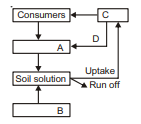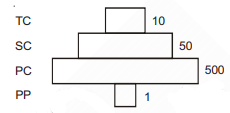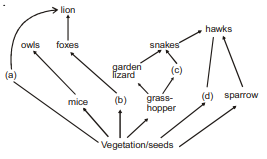Most animals that live in deep oceanic waters are
1. Detritivores
2. Primary consumers
3. Secondary consumers
4. Tertiary consumers
In which of the following both pairs have correct combination?
1. Gaseous nutrient cycle Sulphur and Phosphorus
Sedimentary nutrient cycle Carbon and Nitrogen
2. Gaseous nutrient cycle Carbon and Nitrogen
Sedimentary nutrient cycle Sulphur and Phosphorus
3. Gaseous nutrient cycle Carbon and Sulphur
Sedimentary nutrient cycle Nitrogen and Phosphorus
4. Gaseous nutrient cycle Nitrogen and Sulphur
Sedimentary nutrient cycle Carbon and phosphorus
During ecological succession
1. The changes lead to a community that is in near equilibrium with the environment and is called pioneer community
2. The gradual and predictable change in species composition occurs in a given area
3. The establishment of a new biotic community is very fast in its primary phase
4. The number and types of animals remain constant
Vertical distribution of different species occupying different levels in a biotic community is known as
1. Pyramid
2. Divergence
3. Stratification
4. Zonation
In an ecosystem the rate of production of organic matter during photosynthesis is termed as
1. Net productivity
2. Net primary productivity
3. Gross primary productivity
4. Secondary productivity
Secondary succession takes place on / in
1. Newly cooled lava
2. Bare rock
3. Degraded forest
4. Newly created pond
The mass of living material at a trophic level at a particular time is called
1. Standing crop
2. Gross primary productivity
3. Standing state
4. Net primary productivity
Match the following and select the correct option :
a. Earthworm (i) Pioneer species
b. Succession (ii) Detritivore
c. Ecosystem service (iii) Natality
d. Population growth (iv) Pollination
1. a(i), b(ii), c(iii), d(iv)
2. a(iv), b(i), c(iii), d(ii)
3. a(iii), b(ii), c(iv), d(i)
4. a(ii), b(i), c(iv), d(iii)
Given below is a simplified model of phosphorus cycling in a terrestrial ecosystem with four blanks (A-D). Identify the blanks. 
Options :
A B C D
1. Rock minerals Detritus Litter fall Producers
2. Litter fall Producer Rock minerals Detritus
3. Detritus Rock minerals Producers Litter fall
4. Producers Litter fall Rock minerals Detritus
If 20 J of energy is trapped at producer level, then how much energy will be available to peacock as food in the following chain?
Plant Mice Snake Peacock
1. 0.02 J
2. 0.002 J
3. 0.2 J
4. 0.0002 J
Natural reservoir of phosphorus is
1. Animal bones
2. Rock
3. Fossils
4. Sea water
Secondary productivity is rate of formation of new organic matter by :
1. Parasite
2. Consumer
3. Decomposer
4. Producer
Which one of the following processes during decomposition is correctly described?
1. Humification-Leads to the accumulation of a dark coloured substance humus which undergoes microbial action at a very fast rate
2. Catabolism-Last step in the decomposition under fully anaerobic condition
3. Leaching-Water soluble inorganic nutrients rise to the top layers of soil
4. Fragmentation-Carried out by organisms such as earthworm
The upright pyramid of number is absent in
1. Lake
2. Grassland
3. Pond
4. Forest
Which one of the following is not a gaseous biogeochemical cycle in ecosystem?
1. Nitrogen cycle
2. Carbon cycle
3. Sulphur cycle
4. Phosphorus cycle
Given below is an imaginary pyramid of numbers. What could be one of the possibilities about certain organisms at some of the different levels ? 
1. Level one PP is "pipal trees" and the level SC is "sheep"
2. Level PC is "rates" and level SC is "cats"
3. Level PC is "insects" and level SC is "small insectivorous birds"
4. Level PP is "phytoplanktons" in sea and "Whale" on top level TC
Identify the possible link "A" in the following food chain
Plant insect frog "A" Eagle
1. Cobra
2. Parrot
3. Rabbit
4. Wolf
The second stage of hydrosere is occupied by plants like
1. Azolla
2. Typha
3. Salix
4. Vallisneria
Identify the likely organisms (a), (b), (c) and (d) in the food web shown below 
Options
(a) (b) (c) (d)
1. Deer Rabbit Frog Rat
2. Dog Squirrel Bat Deer
3. Rat Dog Tortoise Crow
4. Squirrel Cat Rat Pigeon
Which one of the following statements is correct for secondary succession?
1. It is similar to primary succession except that it has a relatively fast pace
2. It begins on a bare rock
3. It occurs on a deforested site
4. It follows primary succession
Which one of the following statements for pyramid of energy is incorrect, whereas the remaining three are correct?
1. It is upright in shape
2. Its base is broad
3. It shows energy content of different trophic level organisms
4. It is inverted in shape
Which one of the following animals may occupy more than one trophic levels in the same ecosystem at the same time?
1. Goat
2. Frog
3. Sparrow
4. Lion
Both, hydrarch and xerarch successions lead to
1. Highly dry conditions
2. Excessive wet conditions
3. Medium water conditions
4. Xeric conditions
Of the total incident solar radiation the proportion of PAR is
1. More than 80%
2. About 70%
3. About 60%
4. Less than 50%
The breakdown of detritus into smaller particles by earthworm is a process called
1. Mineralisation
2. Catabolism
3. Humification
4. Fragmentation
The correct sequence of plants in a hydrosere is:
1. Volvox Hydrilla Pistia Scirpus Lantana Oak
2. Pistia Volvox Scirpus Hydrilla Oak Lantana
3. Oak Lantana Volvox Hydrilla Pistia Scirpus
4. Oak Lantana Scirpus Pistia Hydrilla Volvox
About 70% of total global carbon is found in
1. Forests
2. Grasslands
3. Agroecosystems
4. Oceans
Consider the following statements concerning food chains
(a) Removal of 80% tigers from an area resulted in greatly increased growth of vegetation.
(b) Removal of most of the carnivores resulted in an increased population of deers.
(c) The length of food chains is generally limited to 3-4 trophic levels due to energy loss.
(d) The length of food chains may vary from 2 to 8 trophic levels.
Which two of the above statements are correct?
1. a & b
2. b & c
3. c & d
4. a & d
The slow rate of decomposition of fallen logs in nature is due to their
1. Low cellulose content
2. Low moisture content
3. Poor nitrogen content
4. Anaerobic environment around them
Which one of the following ecosystem types has the highest annual net primary productivity?
1. Temperate deciduous forest
2. Tropical rain forest
3. Tropical deciduous forest
4. Temperate evergreen forest